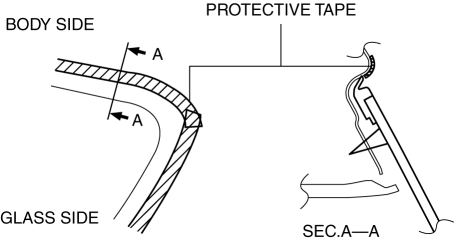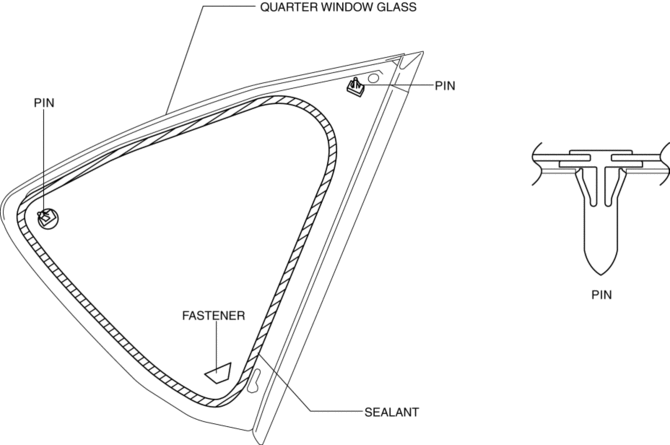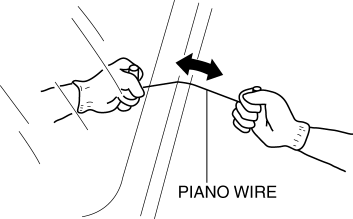Mazda CX-5 Service & Repair Manual: Quarter Window Glass Removal
1. Disconnect the negative battery cable..
2. Remove the following parts:
a. Trunk board.
b. Trunk end trim.
c. Rear scuff plate.
d. Trunk side trim.
e. D-pillar trim.
f. C-pillar trim.
3. Apply protective tape along the edge of the body and the quarter window glass.

WARNING:
-
Using the piano wire with bare hands can cause injury. Always wear gloves when using the
piano wire.
4. Avoiding pins on the inside of the vehicle, insert the piano wire which has been cut to sufficient length.

5. Wind each end of the piano wire around a bar.
NOTE:
-
Use a long sawing action to spread the work over the whole length of the piano wire to prevent it from breaking due to localized heating.
6. Secure one end of the piano wire, and while pulling the other end, cut the sealant around the quarter window glass.

7. Pull the quarter window glass outward and detach the pins from the body.
8. If a pins or fastener is damaged, remove it.
NOTE:
-
Before removing the pins or spacers from the quarter window glass, place alignment marks on the quarter window glass.
 Quarter Window Glass Installation
Quarter Window Glass Installation
WARNING:
Using a razor with bare hands can cause injury. Always wear gloves when using
a razor.
CAUTION:
If a door is opened or closed when all the window glass is closed, the ...
 Rear Door Glass Removal/Installation
Rear Door Glass Removal/Installation
1. Fully lower the rear door glass.
2. Disconnect the negative battery cable..
3. Remove the following parts:
a. Rear door trim.
b. Rear door quarter glass.
c. Rear door speaker.
d. Rear p ...
Other materials:
Controller Area Network (Can) Outline
The Electric Power Steering (EPS) control module sends and receives data
to and from other modules via the CAN..
Data sent
EPS status
Power steering malfunction indicator light on request
Steering angle
Data received
Vehicle speed
Engine spe ...
Registering Your Vehicle in A Foreign Country (Except United States and Canada)
Registering your vehicle in a foreign country may be problematic depending on
whether it meets the specific emission and safety standards of the country in which
the vehicle will be driven. Consequently, your vehicle may require modifications
at personal expense in order to meet the regulation ...
Relay And Fuse Block Disassembly/Assembly
1. Insert a tape-wrapped flathead screwdriver into the service hole in the position
shown in the figure.
2. Move the flathead screwdriver in the direction of the arrow (1) shown in the
figure, pull up relay and fuse block No.1 in the direction of the arrow (2) shown
in the figure, and de ...
